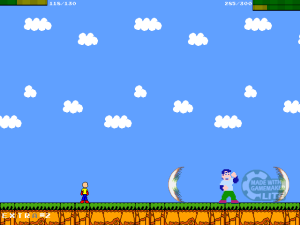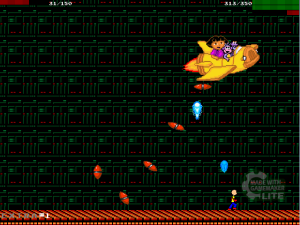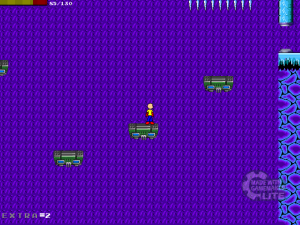By all rights an action platformer in which Dora the Explorer is a boss should be a rushed, barely functional game made primarily as a joke, especially when it bears the impossible-to-ignore GameMaker Lite watermark. This should certainly be the case, yet Generic Man is amongst the better freeware Mega Man-inspired platformers out there. This is not to say that its flawless, the level design could certainly use some work in spots, but Generic Man both adds some nice twists to the Mega Man formula and takes advantage of its exceptionally varied assortment of ripped sprites in some really creative ways.
 It’s easy to use sprites ripped from other games as an alternative to creating original ones, but it is significantly harder to do so in anything outside of a fangame without making the game appear to be lazily-made or unpolished. Taking a cue from I Wanna Be The Guy (and one which sadly few games seem to take note of), Generic Man is a game which uses its assets with care to create a unique collage instead of a mess. Hitboxes always feel spot-on for the enemies and attacks used and existing animations line up surprisingly well, even in situations such as the guy from Urban Champion shooting out Sonic Booms and Hadoukens. There are also little touches all over the place, such as the various Pokémon enemies giving off their various cries when attacking and turning into Poké Balls when defeated. Though each level has a theme, Generic Man is not afraid to mix and match its games, such as Wolfenstein 3D’s Mecha-Hitler leading an army of demons from Doom on the moon (which naturally has the DuckTales moon theme). There’s even an entire stage, PLTFRM6, which uses nothing except the notoriously-awful default GameMaker assets and the theme from Cheetahmen II. The GameMaker watermark really is unfortunate and does actually get in the way at times, but the aesthetics otherwise greatly enhance the entire experience and frequently play with your expectations.
It’s easy to use sprites ripped from other games as an alternative to creating original ones, but it is significantly harder to do so in anything outside of a fangame without making the game appear to be lazily-made or unpolished. Taking a cue from I Wanna Be The Guy (and one which sadly few games seem to take note of), Generic Man is a game which uses its assets with care to create a unique collage instead of a mess. Hitboxes always feel spot-on for the enemies and attacks used and existing animations line up surprisingly well, even in situations such as the guy from Urban Champion shooting out Sonic Booms and Hadoukens. There are also little touches all over the place, such as the various Pokémon enemies giving off their various cries when attacking and turning into Poké Balls when defeated. Though each level has a theme, Generic Man is not afraid to mix and match its games, such as Wolfenstein 3D’s Mecha-Hitler leading an army of demons from Doom on the moon (which naturally has the DuckTales moon theme). There’s even an entire stage, PLTFRM6, which uses nothing except the notoriously-awful default GameMaker assets and the theme from Cheetahmen II. The GameMaker watermark really is unfortunate and does actually get in the way at times, but the aesthetics otherwise greatly enhance the entire experience and frequently play with your expectations.
Depending upon your preferences, you may very well be happy to know that Generic Man is one of the few games which primarily take after the Mega Man X series rather than the original Mega Man series. Along with a double jump, Generic Man’s abilities consist of both a buster shot and a close-range sword slash. Though Generic Man does not gain outright new abilities from defeating bosses, he gradually becomes more colorful and, more importantly, his existing capabilities are permanently enhanced in ways such as his movement speed becoming faster or his shots becoming stronger. Though there is not an energy tank equivalent, there is a permanent health boost to find in every level and a boss fight against a ‘rival’ after killing half and all of the initial bosses.

As Generic Man is a game which is made from the ground up in GameMaker instead of in any sort of existing ‘Mega Man engine’, it contains a few rather useful changes to the standard formula. One particularly nice change is to the way lives work; all the letters of the word ‘EXTRA’ can be collected to grant an additional life, but if you complete a stage after falling below the initial number of lives (three), you automatically get reset to this default value at the main hub instead of needing to worry about entering a new stage with only one or two lives. On a more subtle note, the six initial levels themselves are arranged into two rows of three and, though you can choose to complete them in any order, the two easiest stages are positioned on the left, near the entrance to the main hub as a way of encouraging players to try them out first (they even grant two of the most useful upgrades, a buster shot damage boost and additional jump height).
The most substantial change from the standard Mega Man formula is the ability to switch between three difficulties at any point while in the main hub. Progress is kept between difficulties, so you can switch to an easier difficulty if a stage is giving you too much trouble or you can go ahead and try out a stage at a higher difficulty without losing progress or otherwise needing to redo content. There is an optional boss fight which can only be unlocked by finishing every level on Hard and a few purely-cosmetic pieces of headgear tied to Hard Mode completions, but there is otherwise absolutely no penalty involved for adjusting difficulties (the game even keeps track of your best time on each stage for each difficulty). These difficulty changes aren’t merely damage boosts either as every stage will gain several new hazards and enemies while bosses will become a bit more aggressive and, on the Hard difficulty, gain a new ability.
 If there is one area where Generic Man is lacking, it’s in the level design. Though there are a few level gimmicks, such as exploding blocks in the Mario level and low gravity on the moon, the sense of variety and creativity found within the enemy design is almost completely absent within the levels themselves as the vast majority of the platforming consists of some tricky-yet-bland jumps over pits and across moving platforms, often with a few spikes or some other, less-fatal hazard thrown in. Furthermore, though the controls otherwise feel very solid, the physics in the ice stage feel ‘off’ as the slippery floor will actually send Generic Man backwards if he lands on it after jumping or even if he simply turns around. It doesn’t excuse the subpar design, but most levels are very short and the focus is placed more upon the boss fights, all of which are well-made and highlight Generic Man’s particular brand of creativity even more than the standard enemy designs do. This isn’t to say that the level design is entirely without merit though. While losing all of your lives will still send you back to the hub, checkpoints are extremely frequent and are consistently placed immediately before or after particularly tricky segments. The level layouts themselves may be on the bland side and unique level mechanics may likewise be lacking, especially for a game inspired so heavily by a series like Mega Man X which practically defines itself through unique level mechanics, but enemy placement is actually handled well as enemies are consistently placed both in locations where their attacks are likely to knock Generic Man into a pit or a spike and in groups which work well together, such as ranged enemies being placed directly behind a shielded enemy. Levels aren’t outright horrible or frustrating, but they are, for the most part, disappointingly boring and straightforward.
If there is one area where Generic Man is lacking, it’s in the level design. Though there are a few level gimmicks, such as exploding blocks in the Mario level and low gravity on the moon, the sense of variety and creativity found within the enemy design is almost completely absent within the levels themselves as the vast majority of the platforming consists of some tricky-yet-bland jumps over pits and across moving platforms, often with a few spikes or some other, less-fatal hazard thrown in. Furthermore, though the controls otherwise feel very solid, the physics in the ice stage feel ‘off’ as the slippery floor will actually send Generic Man backwards if he lands on it after jumping or even if he simply turns around. It doesn’t excuse the subpar design, but most levels are very short and the focus is placed more upon the boss fights, all of which are well-made and highlight Generic Man’s particular brand of creativity even more than the standard enemy designs do. This isn’t to say that the level design is entirely without merit though. While losing all of your lives will still send you back to the hub, checkpoints are extremely frequent and are consistently placed immediately before or after particularly tricky segments. The level layouts themselves may be on the bland side and unique level mechanics may likewise be lacking, especially for a game inspired so heavily by a series like Mega Man X which practically defines itself through unique level mechanics, but enemy placement is actually handled well as enemies are consistently placed both in locations where their attacks are likely to knock Generic Man into a pit or a spike and in groups which work well together, such as ranged enemies being placed directly behind a shielded enemy. Levels aren’t outright horrible or frustrating, but they are, for the most part, disappointingly boring and straightforward.

The bland, mostly-short levels may be a deal-breaker for some, but Generic Man is an otherwise very solid action platformer with fun boss fights, surprisingly creative asset usage, and a good number of small, smart touches to both its gameplay and its aesthetics which go a long way towards giving it a great degree of polish and charm.